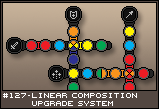| Three Hundred |
| - Index Page |
| - About... |
| - By Year |
| Collections |
| - Comp-Grid |
| - Procedural |
| - Tactics |
| - Tiny Crawl |
| - Misc |
| Previous | Mechanic #127 | Next |
![[coh.png]](set07/img/entry127-coh.png)
When I first played the MMO City of Heroes, I was immediately impressed with their non-traditional upgrade system. Each super power you possess can be upgraded by slotting in various enhancements, like DAMAGE +10% or ACCURACY +10%. In this way, you could customize your attacks, making trade offs between larger area of effort, longer range, more accuracy, or higher critical hits. It's basically the gem system from Diablo II. I say I WAS impressed because I initially thought the system was far more interesting that it actually was. See, I thought the position of the enhancements mattered, as well as their physical relationship to the the adjacent enhancements. As it turned out, City of Heroes did the bare minimum, producing a shallow system that was so obvious to minmax that they had to nerve it repeatedly, to the point where the enhancements barely matter. To make matters worse, you had to keep upgrading them, as the enhancements lose power as you level up - it is entirely possible to get a level up and be less powerful than you were before against equal level enemies. I've had the basic idea for making a composition grid-like version of the CoH enhancement system for a long time, but only recently did I think of a decent twist on the idea that justified its inclusion in the Three Hundred.
![[linear1.png]](set07/img/entry127-linear1.png)
The basic premise is that for each ability (or stat, or whatever you are enhancing), you get a linear group of slots, into which you can install enhancements. These enhancements are added up and contribute to the total enhancement value for the ability as a whole.
![[linear2.png]](set07/img/entry127-linear2.png)
Depending on how you place the enhancements, certain combos may become active, adding additional value to your enhancements. In this example, putting two of the same color next to each other adds 1 to that enhancement score, and putting three of the same color adds 3. The yellow enhancements in the previous example were not next to each other, and thus there was no combo.
![[linear3.png]](set07/img/entry127-linear3.png)
Think of combos like playing Poker. You can get a straight, a flush, two of a kind, and stuff like that. Combos can be any linear series of colors, such as alternating colors, all different colors, or other patterns. Each ability could have unique combos, both obvious and hidden, to create to build a more interesting score system.
![[linear4.png]](set07/img/entry127-linear4.png)
Some enhancements have two different colors on them that count as a particular color only for one side at a time. In this example, you can create two different combos using one double enhancement. It should be noted that double enhancements are not consider adjacent to themselves, so they are effectively only useful as bookends for a combo. Though I guess some combos could require the used of double enhancements.
![[linear5.png]](set07/img/entry127-linear5.png)
Finally, for added challenge, rather than simply putting each enhancement bar separately, connect them vertically and horizontally, like a crossword puzzle. When doing this, each ability has to share enhancements with one or more other abilities, making it more difficult to create easy combos. Similarly, double enhancements can not be used at intersections. Instead, there are quad enhancements, which have four colors.
|
